How to Read a Seed Packet
“Oh, boy,” you must be thinking to yourself right now. “Barbara’s lost her damned mind. Why does she want to write about reading seed packets? Any idiot can read the back of a seed packet….”
Well, yes, and no.
Really what this post is about is understanding the information that most seed companies put on their seed packets, information that many beginning gardeners might find confusing. Gardening has become a very popular pastime, and in the past couple of years, the number of people growing food plants has skyrocketed in the US. According to a recent Vancouver Sun article the number of households in the US which report growing a vegetable garden has risen from 38 percent in 2009 to 53 percent in 2010. In addition, sales of seeds, garden equipment and gardening books have doubled since 2008. (The statistics quoted above were sourced from the 2010 Summer Gardening Trends Research Report, prepared by the Garden Writers Association Foundation.)
That rampant growth of interest in gardening means that there are a lot of new gardeners out there, and that means that its the least we folks who grew up with a shovel in our hands can do to reach out and give a few words of advice to our newly minted gardening brethren.
So, here I am, reaching out to teach folks how to understand the information that is printed on most seed packets, because while most of them are illustrated on the front with beautifully colored pictures, the important stuff is what is usually printed on the back.
Here’s a photo of the back of the “Mammoth” sunflower seed packet put out by Burpee Seeds. This packet was bought at a local feed and seed store here in Athens, and is typical of how most seed companies package their seeds for retail stores.
First comes a description of the plant’s typical characteristics: “Attractive, large yellow flowers grow on 12′ stalks. Hundreds of plump, thin-shelled seeds are ready to harvest from center disk in 80 days. Annual.”
The pertinent information in this description is thus–the plant is 12 feet tall, the seeds are ready to harvest in 80 days and the plant is an annual, meaning you have to replant it or let it seed itself every year.
Next comes the planting instructions: “SOW in average soil after danger of frost. Sow seeds 8″ apart and cover with 1″ of fine soil. Firm lightly and keep evenly moist. Seedlings emerge in 7-14 days. Harvest when flower heads dry on stalk. Continue to air-dry heads in large paper bags for 2-3 weeks.”
These instructions are fairly straightforward, and included in them is the very pertinent piece of information that the seeds germinate and sprout in 7-14 days. That is a very important thing to know because if you note the date when you planted some seeds, it’s helpful to know when to expect to see some sprouts appearing. Otherwise, you may wait too long before replanting for some seeds that don’t germinate, or you might jump the gun and replant before you need to. In one case, you waste time and in other, money.
In addition to the written growing guidelines, you note the graphics that instruct the gardener to plant the seeds in full sun, to a depth of 1 inch, to THIN the plants (which were planted 8 inches apart) to 12-18 inches apart after they have sprouted, and that the plants will then grow 12 feet tall.
The graphics in this case reiterate the written instructions and plant description with one important exception–the graphics show the gardener thinning the seedlings which were planted 8 inches apart to stand 12-18 inches apart. (The easiest way to do this would be to take out every other seedling so they now stand 16 inches apart.) Thinning is important to get plants to grow to their proper size, and to resist disease, so it is interesting that this step was eliminated from the written instructions, but placed in the graphic illustrations.
This shows how important it is to both read the instructions on a seed packet carefully, but to also look at the graphics and understand them as well. In many cases, the two say the same thing, but sometimes, a crucial step is articulated in one and not the other.
Also note that the Burpee seed pack has instructions in both English and Spanish, so the same information is repeated twice on the small packet.
Some seed packets are even more minimalist than the Burpee retail store packets. Here is a packet of seeds that I ordered from Burpee’s website. It doesn’t even have a picture of the plant on its front–this is common when it comes to seeds packaged for mail-order. This saves money on packaging–full color photographic printing is expensive, while one color printing is not. Most seed companies package their seeds this way for direct sale from the internet, phone or mail–note another example in the first photo above–on the left you can see a packet of seeds for Chinese cabbage from Evergreen Seeds, a leading purveyor of Asian vegetable and herb seeds.
The lacinato kale packet, however, still has minimal information on growing the seed, and it is all still in paragraph form, which requires careful reading. In the general description, the harvest time is noted–60-80 days. In the next section marked “SOW,” instructions are given for how to plant the seeds, including when to expect germination. (7-14 days) Then, instructions on how far apart to thin the seedlings is given in the next section, under the bolded word, “THIN.” Then, there is a section called “GARDEN HINTS” which gives the very useful information that kale requires good cultivation or mulching to keep the soil loose and weed-free. It is also noted that kale can be left outdoors all winter and that frost improves the flavor of it.
In contrast, the Evergreen Seed packet not only gives step by step instructions on how to plant, thin and harvest the cabbage in numbered sequential form, it also gives a very helpful graphic table at the top of the packet that notes what spacing to put the plants and rows, how deeply to plant the seeds, germination TEMPERATURE–meaning at what soil temperature the seeds germinate, and days to maturity/harvest.
I personally like seed packets that give those very useful bits of information in a table format because it is easier to find that way while you are in the garden down on your knees with grubby hands, about to plant. It just makes it all easier to find, read and understand while you are in the process of planting a bunch of different seeds all at the same time.
All seed companies put the same basic information on their packets, but as noted–I prefer the companies that put the planting information in easily found and read charts, graphs or tables somewhere on their packet so when I go to actually get down and dirty with the seeds, I don’t have to read through paragraphs to get to what I need to know.
One of my favorite seed companies, not just because they sell quality seed for unusual and heirloom vegetables and flowers, but because their packaging is exemplary is Renee’s Garden. You can see an example of the beautiful art used on the front of their packets in the very first picture above–here you can see a packet of Tricolor Pattypan Squash. All of the packets are illustrated with lovely full-color paintings of the plants with a quote from Renee Shepherd, the founder of the company, that says, “Set a table in the garden,” but of course, that’s not the important part of their packaging.
The important stuff is all on the back.
Turn the packet over and look on the left side. In a pale green box going vertically up the packet is a table of all the really necessary information for the seeds contained therein: planting dates for both cold and warm climates, sun requirements, how to sow the seeds, days until germination, and days to harvest. There it is–easy to find and read at a glance.
But wait, there’s more. Lots more–on a flap attached to the aforementioned pale green type box, is a description of what exact varieties of seed are in this packet, since three different varieties of pattypan squash are to be found there–yellow “Sunburst” pale green “Peter Pan,” and dark green “Starship.” A key to the individual seeds which have been dyed to tell them apart is also given.
I feel like Ron Popeil here, but we’re not through! Lift the flap and detailed instructions on how to plant and thin the seeds and seedlings, and when and how to harvest the squash. Notes are given on how to protect the seeds and seedlings from marauding birds, and as if that was not enough, cooking suggestions are given as well.
So, now that we know what is on most seed packets, how should we go about reading them? First, look for the most necessary information: when to plant, how to plant, how/when to thin the seedlings, time to germination and time to harvest. If these bits of information are not easily found together, I know of some gardeners who take a highlighter to their packets and highlight them before heading out to plant.
But even once you have those facts in front of you, always read the rest of the packet carefully, because all of the information on those packets is useful, if not essential. And, if you don’t understand something in the terminology or you have questions about the last frost date in your town, do not hesitate to seek information online, or even better, to ask a more experienced gardener, such as can easily be found at your local feed and seed store. Or, call your local County Extension Agent and ask them. They are amazing fonts of gardening knowledge that is specialized to your local area.
So, go ye forth, and read your seed packets and then, get planting! Seeds won’t grow themselves, you know! (Except when they do, like in the case of prolific self-seeding plants like dill, nigella and fennel.)
3 Comments
RSS feed for comments on this post.
Sorry, the comment form is closed at this time.
Powered by WordPress. Graphics by Zak Kramer.
Design update by Daniel Trout.
Entries and comments feeds.

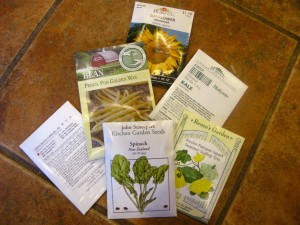
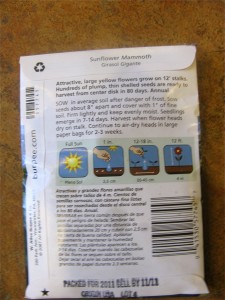
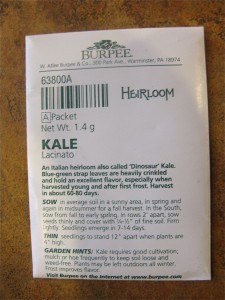
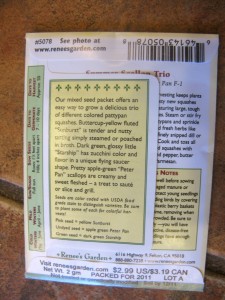
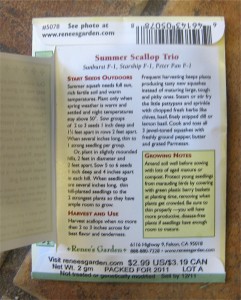


(or blackberries, or cedar trees). Thanks for all the good info. My husband and I are talking about starting a garden this year, although we’re both a bit nervous about it as the only things we’ve managed to not kill are the ficus and the aloe plant. But where we live, supposedly, anything will grow, with very little help from the gardener. We just can’t start planting until almost Memorial Day.
Comment by Kymster — April 22, 2011 #
Thank goodness you are back! We were so worried about you.
Welcome home 🙂
Aarti
Comment by Aarti — April 24, 2011 #
I have several seed packets that have two distances listed for spacing, separated by a slash. For example, I have a packet of cucumber seeds that lists spacing as “4 ft. / 6 ft.”. I also have a packet of Roma Tomato seeds that lists spacing as “3 ft. / 2 ft.” By the graphic, these two numbers seem to indicate plant and row spacing…? But in which order? Thanks!
Comment by Dave — May 14, 2011 #